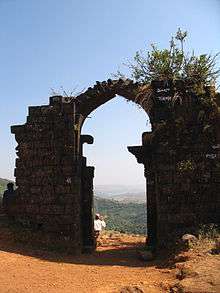Vishalgad
| Vishalgad | |||||
| Jagir of Maratha Empire and then British India | |||||
| |||||
| History | |||||
| • | Established | 1716[3] | |||
| • | Independence of India (abolition of the estate) | 1956[4] | |||
| Area | |||||
| • | 1901 | 608.65 km2 (235 sq mi) | |||
| Population | |||||
| • | 1901 | 30,807 | |||
| Density | 50.6 /km2 (131.1 /sq mi) | ||||
| Source: Solomon & Bond (1922)[5] | |||||
| Vishalgad | |
|---|---|
| Kolhapur district, Maharashtra, India | |
 One of the few surviving structures on Vishalgad | |
 Vishalgad | |
| Coordinates | 16°54′23″N 73°44′30″E / 16.906419°N 73.741683°E |
| Site information | |
| Owner | Government of India |
Vishalgad (also called Vishalgarh, Khelna or Khilna)[6] was a jagir during the Maratha Empire and then later part of the Deccan States Agency of the British Raj. It was governed by Deshastha Brahmins,[7] who were feudatories of Kolhapur State.[8]
Shahu of Kolhapur attempted to undermine the Brahmin princelings of Vishalgad jagir, as also those of Bavda and Ichalkaranji, from around 1895. He had inherited the throne of Kolhapur in 1894 placed blame for the past weak government of his state on Brahmins, including those in its civil service, and claimed that there was justification for discriminating against them in order to improve the lot of his less privileged subjects. Aside from introducing policies of job reservation and education for the underprivileged in his state, he asked the British Raj provincial authorities of Bombay Presidency to allow a reduction in the privileges enjoyed by the feudatory chiefs, whom he claimed had been harbouring Brahmin terrorists from Poona. Historian Gordon Johnson says that "The case, although plausible, was not entirely convincing, and the matter dragged on into the 1920s".[7]
Fort
A fort had existed at Vishalgad long before it became a jagir. The Maratha emperor Shivaji had escaped to it after being besieged at Panhala Fort in 1660[9] and in 1844 it was one of the forts of Kolhapur State that initiated a rebellion against a Brahmin regent called Daji Krishna Pandit who had been installed by the British to govern the state in 1843 at a time when the natural heir to the throne was underage. He took direction from a political agent of the East India Company and among their actions were reforms to the tax of land. These reforms caused much resentment and, despite Kolhapur having refrained from involvement in the previous Anglo-Maratha Wars, a revolt against the British began in 1844. The rebellion began with soldiers locking themselves into hill-forts such as those as Panhala and Vishalgad, and then spread to Kolhapur itself.[10]
See also
References
- ↑ Vishalgad Jagir.
- ↑ Vishalgad Jagir.
- ↑ Vishalgad Jagir.
- ↑ Vishalgad Jagir.
- ↑ Solomon, R. V.; Bond, J. W. (1922). Indian States: A Biographical, Historical, and Administrative Survey. Asian Educational Services. p. 110.
- ↑ "Vishalgad". Maharashtra Tourism Development Corporation. Retrieved 2017-07-14.
- 1 2 Johnson, Gordon (2005). Provincial Politics and Indian Nationalism: Bombay and the Indian National Congress 1880-1915. Cambridge University Press. p. 102.
- ↑ Ramusack, Barbara N. (2004). The Indian Princes and their States. Cambridge University Press. p. 146. ISBN 978-1-13944-908-3.
- ↑ Gordon, Stewart (1993). The Marathas 1600-1818. Cambridge University Press. p. 68. ISBN 978-0-52126-883-7.
- ↑ Gott, Richard (2011). Britain's Empire: Resistance, Repression and Revolt. Verso Books. p. 343. ISBN 978-1-84467-738-2.
| Wikimedia Commons has media related to Vishalgad. |